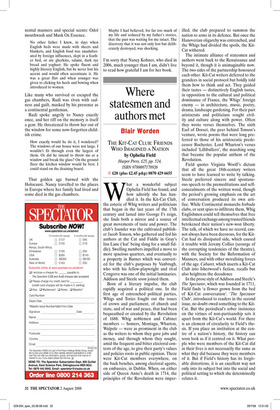Where statesmen and authors met
Blair Worden
THE KIT-CAT CLUB: FRIENDS WHO IMAGINED A NATION by Ophelia Field Harper Press, £25, pp. 524, ISBN 9780007178926 ✆ £20 (plus £2.45 p&p) 0870 429 6655 What a wonderful subject Ophelia Field has found, and P how adroitly she has handled it. In the Kit-Cat Club, the coterie of Whig writers and politicians that began in the last years of the 17th century and lasted into George I’s reign, she finds both a mirror and a source of great movements of taste and power. The club’s founder was the cultivated publisher Jacob Tonson, who gathered and fed his authors at the Cat and Fiddle in Gray’s Inn Lane (‘kat’ being slang for a small fiddle). Swelling numbers impelled a move to more spacious quarters, and eventually to a property in Barnes which was converted for the club’s purposes by Vanbrugh, who with his fellow-playwright and rival Congreve was one of the initial luminaries. Addison and Steele soon joined them.
Born of a literary impulse, the club rapidly acquired a political one. In the first age of entrenched political parties, Whigs and Tories fought out the issues of crown and parliament, of church and state, and of war and peace, that had been bequeathed or created by the Revolution of 1688. Whig noblemen and Cabinet members — Somers, Montagu, Wharton, Walpole — were as prominent in the club as the writers to whom they gave jobs and money, and through whom they sought, amid the frequent and bitter electoral contests of the age, to give their party’s values and policies roots in public opinion. There were Kit-Cat members everywhere, on the back benches, among electoral agents, on embassies, in Dublin. When, on either side of Queen Anne’s death in 1714, the principles of the Revolution were imper illed, the club prepared to summon the nation to arms in its defence. But once the Hanoverian oligarchy was entrenched, and the Whigs had divided the spoils, the KitCat withered.
The intimate alliance of statesmen and authors went back to the Renaissance and beyond it, though it is unimaginable now. The two sides of the partnership honoured each other. Kit-Cat writers deferred to the grandees in social protocol but boldly told them how to think and act. They guided their tastes — distinctively English tastes, in opposition to the cultural and political dominance of France, the Whigs’ foreign enemy — in architecture, music, poetry, drama, landscape gardening. For their part aristocrats and politicians sought civility and culture along with power. Often they wrote verses themselves. The sixth Earl of Dorset, the peer behind Tonson’s venture, wrote poems that were long preferred to those of his aristocratic predecessor Rochester. Lord Wharton’s verses included ‘Lillibullero’, the marching song that became the popular anthem of the Revolution.
Field quotes Virginia Woolf’s dictum that all the great 18th-century writers seem to have learned to write by talking. Steele preferred sincere and spontaneous speech to the premeditations and selfconcealments of the written word, though the period’s growing emphasis on the art of conversation produced its own artifice. While Continental monarchs forbade clubs, or sent spies to infiltrate them, Whig Englishmen could tell themselves that free intellectual exchange among trusted friends betokened their nation’s new-won liberty. The talk, of which we have no record, cannot always have been decorous, for the KitCat had its dissipated side, which caused it trouble with Jeremy Collier (scourge of the corrupting tendencies of the theatre), with the Society for the Reformation of Manners, and with other moralising forces of the age. Cabaret, which inserts a Kit-Cat Club into Isherwood’s fiction, recalls but also heightens the decadence In the prose style of Addison and Steele’s The Spectator, which was founded in 1711, Field finds ‘a flower grown from the bed of Kit-Cat conversation’. ‘The Spectator Club’, introduced to readers in the second issue, no doubt owed something to the KitCat. But the periodical’s sober insistence on the virtues of non-partisanship sets it apart from the Kit-Cat’s world. For there is an element of circularity to Field’s thesis. If you place an institution at the centre of a nation’s history, the history can soon look as if it centred on it. What people who were members of the Kit-Cat did in their lives is not necessarily the same as what they did because they were members of it. But if Field’s history has its forgivable distortions, it is an excellent way not only into its subject but into the social and political setting to which she determinedly relates it.


























































 Previous page
Previous page